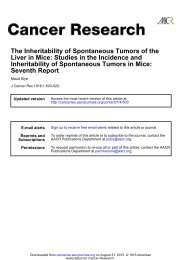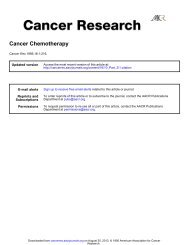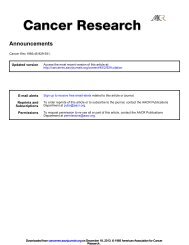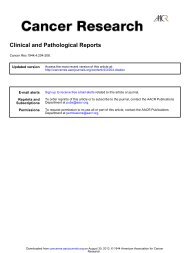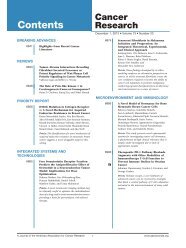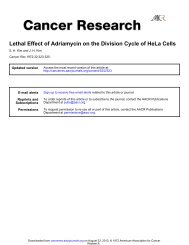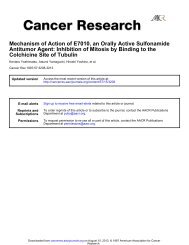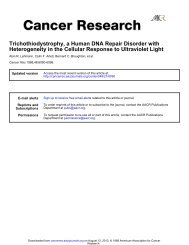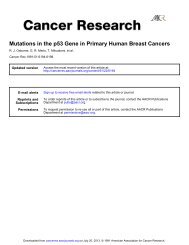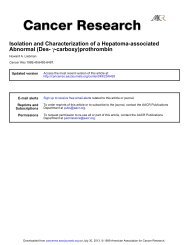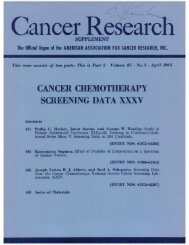Genetic Control of Resistance to Chemically ... - Cancer Research
Genetic Control of Resistance to Chemically ... - Cancer Research
Genetic Control of Resistance to Chemically ... - Cancer Research
Create successful ePaper yourself
Turn your PDF publications into a flip-book with our unique Google optimized e-Paper software.
<strong>Genetic</strong> <strong>Control</strong> <strong>of</strong> <strong>Resistance</strong> <strong>to</strong> <strong>Chemically</strong> Induced Mammary<br />
Adenocarcinogenesis in the Rat<br />
John T. Isaacs<br />
<strong>Cancer</strong> Res 1986;46:3958-3963.<br />
Updated Version<br />
Citing Articles<br />
Access the most recent version <strong>of</strong> this article at:<br />
http://cancerres.aacrjournals.org/content/46/8/3958<br />
This article has been cited by 12 HighWire-hosted articles. Access the articles at:<br />
http://cancerres.aacrjournals.org/content/46/8/3958#related-urls<br />
E-mail alerts Sign up <strong>to</strong> receive free email-alerts related <strong>to</strong> this article or journal.<br />
Reprints and<br />
Subscriptions<br />
Permissions<br />
To order reprints <strong>of</strong> this article or <strong>to</strong> subscribe <strong>to</strong> the journal, contact the AACR Publications<br />
Department at pubs@aacr.org.<br />
To request permission <strong>to</strong> re-use all or part <strong>of</strong> this article, contact the AACR Publications<br />
Department at permissions@aacr.org.<br />
Downloaded from<br />
cancerres.aacrjournals.org on February 22, 2013<br />
Copyright © 1986 American Association for <strong>Cancer</strong> <strong>Research</strong>
(CANCER RESEARCH 46, 3958-3963, August 1986]<br />
<strong>Genetic</strong> <strong>Control</strong> <strong>of</strong> <strong>Resistance</strong> <strong>to</strong> <strong>Chemically</strong> Induced Mammary<br />
Adenocarcinogenesis in the Rat1<br />
John T. Isaacs<br />
Oncology Center and Department <strong>of</strong> Urology, The Johns Hopkins University School <strong>of</strong> Medicine, Baltimore, Maryland 21205<br />
ABSTRACT<br />
Fifty-day-old female rats <strong>of</strong> a series <strong>of</strong> outbred (i.e., SD) and inbred<br />
(i.e., NSD, WF, LEW, F344, ACI, and COP) strains were exposed <strong>to</strong> a<br />
single dose <strong>of</strong> either <strong>of</strong> two highly effective mammary chemical carcino<br />
gens, 7,12-dimethylbenzfa|anthracene (DMBA) or 1-methyl-1-nitrosourea<br />
(MM), <strong>to</strong> determine the characteristic number <strong>of</strong> mammary adenocarcinomas<br />
induced/rat for each strain. Female rats <strong>of</strong> the inbred NSD,<br />
WF, and LEW strains were found <strong>to</strong> be as highly susceptible <strong>to</strong> DMBA<br />
exposure as the randomly outbred SD strain (i.e., >2 mammary adenocarcinomas/rat<br />
develop). Inbred female F344 and ACI rats were found <strong>to</strong><br />
be much less susceptible <strong>to</strong> DMBA induced mammary adenocarcinogenesis<br />
(i.e., 2 years).<br />
Inbred female BN and F344 rats are less susceptible, with only<br />
6% <strong>of</strong> either <strong>of</strong> these strains developing mammary cancer during<br />
their lifetimes (6-8). The inbred ACI female is even less suscep<br />
tible with only 4% <strong>of</strong> these animals developing mammary cancer<br />
if untreated (9). Inbred female COP rats are the most resistant<br />
<strong>to</strong> developing mammary cancer with not a single mammary<br />
cancer appearing among over 1500 <strong>of</strong> these female rats allowed<br />
<strong>to</strong> live out their normal lifetimes without any exogenous treat<br />
ment (10).<br />
This same gradation in susceptibility is observed with regard<br />
<strong>to</strong> mammary cancer induction by AAF2 (11, 12). When SD,<br />
inbred OM, or inbred BUF female rats are chronically fed AAF,<br />
more than two-thirds <strong>of</strong> the animals develop mammary cancer<br />
with less than 10% developing liver cancer (11). When<br />
F344 (11) or inbred AUG (12) rats are fed AAF, 10-20% <strong>of</strong><br />
animals develop mammary cancer and 10-20% develop liver<br />
cancer. Only 8% <strong>of</strong> ACI rats (11, 12) fed AAF develop mam<br />
mary cancer while liver cancer develops in 34% <strong>of</strong> these animals.<br />
Female COP rats were completely resistant <strong>to</strong> AAF induction<br />
Received 12/10/85; revised 4/11/86; accepted 5/2/86.<br />
The costs <strong>of</strong> publication <strong>of</strong> this article were defrayed in part by the payment<br />
<strong>of</strong> page charges. This article must therefore be hereby marked advertisement in<br />
accordance with 18 U.S.C. Section 1734 solely <strong>to</strong> indicate this fact.<br />
'Supported by Grants from the American <strong>Cancer</strong> Society (IN-I1U) and<br />
Department <strong>of</strong> Health and Human Services (CA 42954).<br />
1The abbreviations used are: AAF, 2-acetylamin<strong>of</strong>luorene; DMBA, dimethylbenz[a]anthracene;<br />
MNU,l-methyl-l-nitrosourea.<br />
<strong>of</strong> mammary cancer (12). Female COP rats did develop, how<br />
ever, a 20% incidence <strong>of</strong> liver cancer demonstrating that not all<br />
tissues in this strain are resistant <strong>to</strong> AAF.<br />
Chronic treatment <strong>of</strong> female rats with exogenous estrogens,<br />
like AAF feeding, is an efficient inducer <strong>of</strong> mammary cancer<br />
development in some strains <strong>of</strong> rats and not others (13, 14).<br />
Chronic (i.e., >1 year) high dose estrogen treatment <strong>of</strong> SD (13),<br />
AUG (14), or ACI (14) rats results in more than 40% <strong>of</strong> all<br />
treated animals developing mammary cancers. Inbred LEW<br />
(13) and F344 (13) rats are less susceptible <strong>to</strong> exogenous<br />
estrogen treatment, developing only a 31 and 16% incidence <strong>of</strong><br />
mammary cancer, respectively. Again, the mammary glands <strong>of</strong><br />
the female COP are completely resistant (i.e., 0% incidence) <strong>to</strong><br />
such high dose estrogen treatment (14). This chronic estrogen<br />
treatment does produce, however, a 20% incidence <strong>of</strong> bladder<br />
cancer in these female COP rats (14), again demonstrating that<br />
not all tissues in this strain are <strong>of</strong> the resistant phenotype.<br />
These background data demonstrate that various strains <strong>of</strong><br />
female rats are not equally susceptible <strong>to</strong> the induction <strong>of</strong><br />
mammary cancer and that the female COP rat might be genet<br />
ically unique in its resistance <strong>to</strong> mammary adenocarcinogenesis,<br />
regardless <strong>of</strong> what type <strong>of</strong> carcinogenic treatment is used. There<br />
are a series <strong>of</strong> chemical carcinogens (e.g., DMBA and MNU)<br />
which are known <strong>to</strong> be highly effective in inducing the devel<br />
opment <strong>of</strong> mammary cancers in female rats <strong>of</strong> certain strains<br />
following a single exposure (5, 15). Therefore, female rats from<br />
a series <strong>of</strong> inbred strains including the COP were separately<br />
treated with DMBA and MNU <strong>to</strong> determine the resistance<br />
versus susceptibility <strong>of</strong> each strain <strong>to</strong> mammary adenocarcinoma<br />
development.<br />
MATERIALS AND METHODS<br />
Animals. Randomly outbred Sprague-Dawley (SD/HsdBr), inbred<br />
ACI/Seg (ACI/SegHsdBR), inbred Fischer (F344/NHsdBr), inbred<br />
Wistar-Furth (WF/NHsd3R), inbred COP (COP/NHsdBr), and inbred<br />
Lewis (LEW/NHsdBr) rats were obtained from HarÃanSprague-Daw<br />
ley, Inc. (Indianapolis, IN). The inbred Sprague-Dawley (NSD/N)<br />
animals were derived from an in-house colony established from a<br />
breeding nucleus <strong>of</strong> NSD rats obtained at the 54th brother x sister<br />
generation through the generosity <strong>of</strong> the Veterinary Resources Branch<br />
<strong>of</strong> the NIH <strong>Genetic</strong> Resource. Following exposure <strong>to</strong> carcinogen, as<br />
described below, all animals were housed in a Vickers Total Contain<br />
ment Isolation Unit (London, United Kingdom) for 1 month before<br />
being returned <strong>to</strong> normal animal rooms. Animals were housed in a<br />
room lighted 12 h/day and maintained at a temperature <strong>of</strong> 23°C.All<br />
rats were palpated for mammary tumors twice weekly with the time <strong>of</strong><br />
detection post-carcinogen exposure being individually recorded for each<br />
tumor which developed in each rat.<br />
The rats in each grouping underwent a complete au<strong>to</strong>psy at the time<br />
<strong>of</strong> spontaneous death or at 365 days post-carcinogen exposure. At the<br />
time <strong>of</strong> au<strong>to</strong>psy all grossly detectable mammary tumors (i.e., >2 mm<br />
in diameter) were removed and fixed in 10% buffered formalin, and<br />
paraffin sections were prepared and stained with hema<strong>to</strong>xylin and eosin.<br />
Each mammary tumor was individually classified his<strong>to</strong>pathologically<br />
according <strong>to</strong> the criteria <strong>of</strong> Van Zwieten (16). This his<strong>to</strong>lógica!evalu<br />
ation thus allowed the number <strong>of</strong> detectable mammary adenocarcino<br />
mas, sarcomas, and fibroadenomas for each rat <strong>to</strong> be individually<br />
3958<br />
Downloaded from<br />
cancerres.aacrjournals.org on February 22, 2013<br />
Copyright © 1986 American Association for <strong>Cancer</strong> <strong>Research</strong>
assigned; therefore, the mean number <strong>of</strong> mammary adenocarcinomas<br />
per rat for each experimental treatment group could be determined at<br />
various times post-carcinogen exposure. The mean values ±SE for the<br />
mammary adenocarcinomas per animal for each group were determined<br />
by dividing the number <strong>of</strong> new mammary adenocarcinomas observed<br />
within the group in each 10-day interval by the number <strong>of</strong> rats at risk<br />
in that interval and then summing these values by the method <strong>of</strong><br />
McCormick et al. (5). This calculation thus takes in<strong>to</strong> consideration<br />
intercurrent mortality.<br />
Carcinogenic Exposure. For the systemic exposure <strong>to</strong> DMBA, groups<br />
<strong>of</strong> animals were given either a single or multiple doses <strong>of</strong> sesame oil<br />
containing varying amounts <strong>of</strong> DMBA by means <strong>of</strong> gastric intubation<br />
according <strong>to</strong> the method <strong>of</strong> Huggins et al. (15). For the direct in vivo<br />
exposure <strong>of</strong> mammary glands <strong>to</strong> DMBA. the technique <strong>of</strong> Sinha and<br />
Dao (17) was used. This involves anesthetizing rats with Met<strong>of</strong>ane<br />
(Pittman-Moore, Inc., Washing<strong>to</strong>n Crossing, NJ), exposing the right<br />
inguinal mammary gland, dusting 3mg <strong>of</strong> a 2:1 mixture <strong>of</strong> cholesterol<br />
and DMBA (i.e., 1 mg DMBA <strong>to</strong>tal) directly on<strong>to</strong> the exposed gland,<br />
and then closing the skin incision with stainless steel au<strong>to</strong>clips.<br />
For the MNU experiments, groups <strong>of</strong> rats were given either a single<br />
or multiple injections <strong>of</strong> MNU via the femoral vein according <strong>to</strong> the<br />
method <strong>of</strong> Cullino et al. (18). Some rats were also given s.c. injections<br />
<strong>of</strong> a single dose <strong>of</strong> MNU according <strong>to</strong> the method <strong>of</strong> Thompson and<br />
Meeker (19). For i.v. or s.c. injections, MNU was dissolved in 0.85%<br />
NaCl solution adjusted <strong>to</strong> pH 5.0 with 3% acetic acid. DMBA and<br />
MNU were obtained from Sigma Chemical Co. (St. Louis, MO).<br />
RESULTS<br />
DMBA Experiments. When 20 mg <strong>of</strong> DMBA are adminis<br />
tered systemically via a single s<strong>to</strong>mach tube feeding <strong>to</strong> 50-dayold<br />
female SD rats, greater than 90% <strong>of</strong> the animals develop<br />
multiple mammary adenocarcinomas within 1 year (Fig. 1).<br />
Like the randomly outbred SD rat, 50-day-old inbred NSD,<br />
inbred WF, and inbred LEW female rats are all equally highly<br />
susceptible <strong>to</strong> multiple mammary adenocarcinoma development<br />
following DMBA exposure (Fig. 1). Following a single feeding<br />
<strong>of</strong> 20 mg <strong>of</strong> DMBA, female F344 rats are less susceptible <strong>to</strong><br />
development <strong>of</strong> mammary adenocarcinoma and female ACI<br />
rats are even less susceptible (Fig. 1). In direct contrast <strong>to</strong> the<br />
other strains, the mammary glands <strong>of</strong> female COP rats are<br />
resistant <strong>to</strong> p.o. DMBA feeding. None <strong>of</strong> a series <strong>of</strong> twenty five<br />
50-day-old female COP rats fed 20 mg <strong>of</strong> DMBA developed<br />
any detectable mammary adenocarcinomas even if these treated<br />
rats were allowed <strong>to</strong> live for more than 2 years following dosing.<br />
At 50 days <strong>of</strong> age, there are differences in the body weights<br />
3.0!<br />
5O 100 150 200 250 300 350<br />
GENETIC RESISTANCE TO MAMMARY CANCER<br />
FISCHER<br />
Doys Posi DMBA Feeding<br />
Fig. 1. Temporal pattern <strong>of</strong> mammary adenocarcinoma development in var<br />
ious strains <strong>of</strong> female rats following a single p.o. feeding <strong>of</strong> 20 mg <strong>of</strong> DMBA. A<br />
<strong>to</strong>tal <strong>of</strong> twenty-five 50-day-old female rats were dosed for each strain.<br />
between the various strains <strong>of</strong> female rats tested. Since each<br />
strain <strong>of</strong> rat received a single feeding <strong>of</strong> 20 mg <strong>of</strong> DMBA, this<br />
resulted in differences in the dose <strong>of</strong> DMBA (mg/kg body<br />
weight) when normalized on a body weight basis (i.e., SD, 133;<br />
NSD, 133; WF, 160; LEW, 148; F344, 200; ACI, 200; COP,<br />
200 mg). The fact that the high susceptibility SD, NSD, WF,<br />
and LEW strains actually received a lower dose <strong>of</strong> DMBA,<br />
when expressed on a body weight basis, as compared <strong>to</strong> the low<br />
susceptibility F344 and ACI and resistant COP strains, dem<br />
onstrates that the rank order <strong>of</strong> susceptibility or resistance <strong>to</strong><br />
DMBA cannot be trivially explained by differences in body<br />
weights at time <strong>of</strong> carcinogen exposure.<br />
When female SD rats are exposed multiple times <strong>to</strong> p.o.<br />
feeding <strong>of</strong> DMBA, the number <strong>of</strong> mammary adenocarcinomas<br />
induced per rat increases synergistically, not merely additively,<br />
as compared <strong>to</strong> a single dose exposure (20). Therefore, 10<br />
female COP rats were fed 10 mg <strong>of</strong> DMBA 3 times, at weekly<br />
intervals, starting at 36 days <strong>of</strong> life. The animals were followed<br />
for up <strong>to</strong> 1 year <strong>of</strong> life, or until moribund, during which time<br />
no mammary adenocarcinomas developed although 50% <strong>of</strong> the<br />
treated groups did develop leukemia, which was transplantable<br />
by means <strong>of</strong> inoculation <strong>of</strong> donor blood in<strong>to</strong> recipient untreated<br />
COP rats. An additional group <strong>of</strong> 10 COP female rats was fed<br />
5 mg <strong>of</strong> DMBA four times at weekly intervals starting at 36<br />
days <strong>of</strong> life with the same result (i.e., no mammary cancers,<br />
60% incidence <strong>of</strong> leukemia). As a point <strong>of</strong> comparison, NSD<br />
rats given the same 5-mg, four-dose feeding schedule developed<br />
4.0 ±0.5 mammary adenocarcinomas/rat within 200 days.<br />
Since pregnancy commencing after carcinogen exposure has<br />
been shown <strong>to</strong> sharply increase mammary cancer development<br />
and growth in certain strains (21), 20 female COP rats were fed<br />
20 mg <strong>of</strong> DMBA p.o. at 50 days <strong>of</strong> life and then 1 week later<br />
were bred. These animals were allowed <strong>to</strong> deliver their litters<br />
and then were rebred for a minimum <strong>of</strong> four pregnancies. These<br />
animals were followed for over 1 year and only 1 mammary<br />
adenocarcinoma developed in the 20 treated rats (i.e., average<br />
<strong>of</strong> 0.05 ±0.05 mammary adenocarcinomas/rat).<br />
If 1 mg <strong>of</strong> DMBA is directly applied <strong>to</strong> an exposed inguinal<br />
mammary gland <strong>of</strong> SD rat, mammary adenocarcinomas develop<br />
in 100% <strong>of</strong> the directly exposed glands within 200 days but in<br />
0% <strong>of</strong> the unexposed mammary glands <strong>of</strong> the treated hosts<br />
(17). A series <strong>of</strong> inbred rat strains were tested using this direct<br />
application technique. The right inguinal mammary gland <strong>of</strong><br />
10 rats/strain were directly exposed <strong>to</strong> 1 mg <strong>of</strong> DMBA. In the<br />
NSD group, all exposed glands (i.e., 100%) developed mam<br />
mary adenocarcinomas within 200 days; for the WF strain, also<br />
100% incidence; for the F344 strain, 40% incidence; for the<br />
ACI, 25% incidence; and for the COP, 10% incidence <strong>of</strong> mam<br />
mary adenocarcinoma with a 40% incidence <strong>of</strong> fibrosarcoma<br />
formation.<br />
If 50-day-old SD rats are given ¡.p.injections <strong>of</strong> an oil<br />
emulsion containing 5 mg <strong>of</strong> DMBA, all animals develop<br />
mammary adenocarcinomas (22). Therefore, ten 50-day-old<br />
female NSD rats were given injections <strong>of</strong> an oil emulsion <strong>of</strong> 5<br />
mg <strong>of</strong> DMBA and all animals developed mammary adenocar<br />
cinomas (i.e., 1.2 ±0.1 mammary adenocarcinomas/rat) and<br />
one animal (i.e., 10%) developed an abdominal sarcoma. In<br />
contrast, when ten 50-day-old female COP rats were similarly<br />
given i.p. injections <strong>of</strong> DMBA, no animal developed mammary<br />
cancer; however, 40% <strong>of</strong> these COP animals developed i.p.<br />
sarcomas.<br />
MNU Experiments. DMBA is known <strong>to</strong> require metabolic<br />
conversion <strong>to</strong> its ultimate carcinogen (23). The mammary epi<br />
thelial cells <strong>of</strong> female COP rats might be unable <strong>to</strong> properly<br />
3959<br />
Downloaded from<br />
cancerres.aacrjournals.org on February 22, 2013<br />
Copyright © 1986 American Association for <strong>Cancer</strong> <strong>Research</strong>
GENETIC RESISTANCE TO MAMMARY CANCER<br />
activate DMBA, thus explaining the resistance <strong>of</strong> this tissue <strong>to</strong><br />
DMBA. In order <strong>to</strong> eliminate this complication, another known<br />
direct acting mammary carcinogen, MNU, was tested [i.e.,<br />
MNU does not require metabolic activation <strong>to</strong> be carcinogenic<br />
(24)]. Therefore, ten 50-day-old female NSD, F344, and COP<br />
rats were given i.v. injections <strong>of</strong> MNU (50 mg/kg body weight).<br />
Within 6 months, all <strong>of</strong> the NSD rats developed multiple<br />
mammary adenocarcinomas (i.e., average, 3.0 ±0.4 mammary<br />
adenocarcinomas/rat). In contrast, within 1 year, only 1.2 ±<br />
0.3 mammary adenocarcinomas developed/F344 rat while none<br />
<strong>of</strong> the COP rats developed any mammary cancers. MNU treat<br />
ment <strong>of</strong> COP rats did induce the development <strong>of</strong> leukemia<br />
(10%) and kidney cancers (20%) at an incidence essentially<br />
identical with that <strong>of</strong> the NSD and F344 strains.<br />
MNU injected s.c. at a dose <strong>of</strong> 50 mg/kg body weight can<br />
also induce a high yield <strong>of</strong> mammary cancer in 50-day-old<br />
female SD rats (19). Therefore, ten 50-day-old female COP and<br />
NSD rats were inoculated s.c. with MNU (50 mg/kg). The<br />
incidence <strong>of</strong> mammary adenocarcinoma for the NSD group was<br />
2.4 ±0.3 mammary adenocarcinomas/rat within 1 year, while<br />
only a single mammary adenocarcinoma developed in 1 <strong>of</strong> the<br />
10 COP rats (i.e., 0.1 ±0.1 mammary adenocarcinomas/rat).<br />
When MNU treatment <strong>of</strong> female SD rats is given, starting at<br />
50 days <strong>of</strong> age, as either two i.v. injections <strong>of</strong> 50 mg/kg l week<br />
apart (25) or as three i.v. injections <strong>of</strong> 50 mg/kg at monthly<br />
intervals (18), little <strong>to</strong>xicity is produced and a very high inci<br />
dence <strong>of</strong> multiple mammary adenocarcinomas develop per<br />
treated rat. Therefore, similar MNU treatments were performed<br />
on inbred 50-day-old female NSD and COP rats (i.e., 10 rats/<br />
strain). When two injections <strong>of</strong> MNU were given, the NSD rats<br />
developed an average <strong>of</strong> 3.9 ±0.5 mammary adenocarcinomas/<br />
rat and the COP rats developed 0 mammary adenocarcinomas/<br />
rat. When the three-injection schedule was used, an average <strong>of</strong><br />
4.8 ±0.4 mammary cancers developed/NSD rat, while again<br />
no mammary cancers developed in any <strong>of</strong> the COP rats.<br />
<strong>Genetic</strong> Analysis <strong>of</strong> <strong>Resistance</strong> <strong>to</strong> <strong>Chemically</strong> Induced Mam<br />
mary Adenocarcinogenesis. <strong>Genetic</strong> breeding techniques were<br />
used <strong>to</strong> determine how the resistance <strong>of</strong> the female COP rat <strong>to</strong><br />
DMBA induced mammary adenocarcinogenesis is inherited<br />
[i.e., is it due <strong>to</strong> one or a series <strong>of</strong> dominant or recessive genetic<br />
alÃeles,or is it instead due <strong>to</strong> polygenic (i.e., blended) inherit<br />
ance?]. Parental inbred (i.e., homozygous) NSD and COP rats<br />
were cross-bred <strong>to</strong> produce heterozygous F, hybrid animals.<br />
Both NSD x COP F, and COP x NSD F, hybrids were bred<br />
and at 50 days <strong>of</strong> age were fed 20 mg <strong>of</strong> DMBA p.o. Regardless<br />
<strong>of</strong> which type <strong>of</strong> F! hybrid was used, both were equally resistant<br />
<strong>to</strong> DMBA induced mammary adenocarcinoma development<br />
(Table 1). If resistance was due <strong>to</strong> multiple genetic alÃeles,none<br />
<strong>of</strong> which were dominant (i.e., polygenic inheritance), or <strong>to</strong> a<br />
single sex chromosome linked alÃele,then the FI hybrids should<br />
have been exactly intermediate in their susceptibility between<br />
the NSD and COP strains (i.e., F, hybrids should have had<br />
approximately 1.2 mammary1 carcinomas/rat, not 0.3). If re<br />
sistance was due <strong>to</strong> either one or a series <strong>of</strong> recessive au<strong>to</strong>somal<br />
alÃeles,then the FI hybrid should have been just as susceptible<br />
as the highly susceptible NSD parental strain. The fact that<br />
both types <strong>of</strong> FI hybrids were resistant, like their COP parental<br />
strain, demonstrates that the differential resistance <strong>of</strong> COP<br />
versus NSD female rats is genetically controlled by either one<br />
dominant or several codominant au<strong>to</strong>somal alÃelesand that no<br />
material fac<strong>to</strong>rs (e.g., milk agent) is involved. Since no material<br />
fac<strong>to</strong>r was demonstrated, all subsequent FI hybrid animals were<br />
produced by breeding NSD females <strong>to</strong> COP males.<br />
In order <strong>to</strong> determine if a single dominant au<strong>to</strong>somal alÃele<br />
Table 1 incidence <strong>of</strong> mammary adenocarcinomas induced by p.o. DMBA feeding<br />
in parental and hybrid crosses between NSD and COP rats<br />
adenocarcinomas/ratType<br />
<strong>of</strong> female<br />
dosedNSD rat<br />
COPFI<br />
hybrids<br />
NSD x COP<br />
COP x NSD<br />
Total<br />
F2 hybrids'<br />
COP x F, backcrosses''<br />
No. <strong>of</strong> mammary<br />
(0/25)0.20 0.00<br />
±0.30°(68/25)*<br />
based upon<br />
a single dominant<br />
au<strong>to</strong>somal<br />
resistance alÃele0.77<br />
±0.13 (2/10)<br />
0.40 ±0.16 (4/10)<br />
0.3 ±0.12 (6/20)<br />
0.80 + 0.27(12/15)<br />
0.06 + 0.03(1/17)<br />
NSD x F, backcrosses'Observed2.48<br />
1.00 ±0.17 (17/17)Expected<br />
" Mean ±SE.<br />
0.15<br />
1.39<br />
* Numbers in parentheses, ratio <strong>of</strong> the <strong>to</strong>tal number <strong>of</strong> mammary cancers<br />
which developed <strong>to</strong> the <strong>to</strong>tal number <strong>of</strong> female animals exposed <strong>to</strong> DMBA per<br />
grouping.<br />
f Produced by breeding NSD x COP F, hybrids.<br />
' COP female x (NSD x COP) F, male hybrid backcrosses.<br />
' NSD female x (NSD x COP) F, male hybrid backcrosses.<br />
or several codominant au<strong>to</strong>somal alÃelescontrol this DMBA<br />
resistance <strong>of</strong> the female COP rat, F, hybrids were cross-bred <strong>to</strong><br />
themselves <strong>to</strong> produce F2 hybrids or separately cross-bred <strong>to</strong><br />
female rats <strong>of</strong> either the NSD or COP parental strains <strong>to</strong><br />
produce the appropriate backcrossed animals. At 50 days <strong>of</strong><br />
age, these additional animals were given 20 mg <strong>of</strong> DMBA p.o.<br />
and their responses were determined (Table 1). If the resistance<br />
<strong>of</strong> the female COP rat <strong>to</strong> DMBA is due <strong>to</strong> a single dominant<br />
au<strong>to</strong>somal resistance alÃele,then 0.77 mammary adenocarcinoma/rat<br />
would be expected in the F2 generation (see "Appen<br />
dix" for theoretical calculations). In contrast, if this resistance<br />
is due <strong>to</strong> multiple codominant au<strong>to</strong>somal alÃeles(i.e., several<br />
independently segregating au<strong>to</strong>somal genes, the presence <strong>of</strong> any<br />
one <strong>of</strong> which can confer complete resistance), then the number<br />
<strong>of</strong> mammary cancers present in the F2 generation should be<br />
even lower (e.g., 0.42 and 0.33 mammary adenocarcinomas/rat<br />
expected if 2 or 3 codominant alÃeleswere involved, respec<br />
tively; see "Appendix" for theoretical calculations). The results<br />
<strong>of</strong> the F2 generation studies are thus at odds with a codominant<br />
model <strong>of</strong> inheritance and instead are consistent with the resist<br />
ance being due <strong>to</strong> the inheritance <strong>of</strong> a single dominant au<strong>to</strong>so<br />
mal alÃele.Additional support for a single dominant alÃelebeing<br />
responsible for this resistance is provided by the data on the<br />
mean number <strong>of</strong> mammary adenocarcinomas induced by<br />
DMBA in the COP x F, and NSD x F, backcross animals<br />
(Table 1).<br />
Examination <strong>of</strong> the distribution <strong>of</strong> the number <strong>of</strong> mammary<br />
adenocarcinomas/individual rat (Fig. 2) also supports this con<br />
clusion. In the F2 segregating generation, both the parental<br />
homozygous phenotypes (i.e., COP-RR type with 0 mammary<br />
cancers per rat, and NSD-rr type with >1 mammary cancer/<br />
rat), as well as the hybrid heterozygous phenotype (i.e., Rr with<br />
< 1 mammary cancer/rat), are observed with the expected fre<br />
quency if the resistance <strong>of</strong> the female COP rat <strong>to</strong> DMBA is due<br />
<strong>to</strong> a single dominant au<strong>to</strong>somal alÃele.In order <strong>to</strong> determine<br />
the generality <strong>of</strong> this dominant au<strong>to</strong>somal type <strong>of</strong> mendelian<br />
inheritance, similar studies were performed using MNU as the<br />
carcinogen. At 50 days <strong>of</strong> age, groups <strong>of</strong> female NSD, COP,<br />
FI, and F2 rats were given a single 50-mg/kg i.v. injection <strong>of</strong><br />
MNU. The mean number <strong>of</strong> mammary adenocarcinomas per<br />
rat for these various groups again demonstrated that resistance<br />
<strong>of</strong> the female COP rat <strong>to</strong> MNU is due <strong>to</strong> a dominant au<strong>to</strong>somal<br />
alÃele(Table 2).<br />
Additional genetic analyses were performed on FI hybrid<br />
3960<br />
Downloaded from<br />
cancerres.aacrjournals.org on February 22, 2013<br />
Copyright © 1986 American Association for <strong>Cancer</strong> <strong>Research</strong>
lOO-i SPRAGUE- DAWLEY<br />
2345<br />
00-5O-75250COPENHAGEN12345F<br />
O I 2<br />
Number <strong>of</strong> Mammary Adenocarcinomas/Rat<br />
Fig. 2. Distribution <strong>of</strong> the number <strong>of</strong> mammary adenocarcinomas per rat<br />
which developed in parental and hybrid crosses between NSD and COP female<br />
rats following a single p.o. feeding <strong>of</strong> 20 mg <strong>of</strong> DMBA. Based upon the animals<br />
presented in Table 1.<br />
Table 2 Incidence <strong>of</strong> mammary adenocarcinomas induced by i.v. MNU injection<br />
in parental and hybrid crosses between NSD and COP rats<br />
adenocarcinomas/ratType<br />
<strong>of</strong> female<br />
dosedNSD rat<br />
No. <strong>of</strong> mammary<br />
±0.40°(30/10)*<br />
COP<br />
0.00 (0/10)<br />
F, hybrids'<br />
0.40 ±0.13 (4/10)<br />
F2 hybrids'*Observed3.00<br />
1.00 ±0.35 (12/1 2)Expected<br />
' Mean ±SE.<br />
* Numbers in parentheses, ratio <strong>of</strong> the <strong>to</strong>tal number <strong>of</strong> mammary adenocarci<br />
nomas which developed <strong>to</strong> the <strong>to</strong>tal number <strong>of</strong> animals exposed <strong>to</strong> MNU per<br />
grouping.<br />
c NSD x COP F, hybrids.<br />
rfProduced by breeding NSD X COP F, hybrids.<br />
female rats produced by cross-breeding WF females (i.e., an<br />
other high susceptibility inbred strain), <strong>to</strong> male COP rats. At<br />
50 days <strong>of</strong> age, groups <strong>of</strong> 10 rats each <strong>of</strong> the WF, COP, and<br />
their FI hybrid strains were given 20 mg <strong>of</strong> DMBA p.o. Within<br />
1 year, the parental WF strain developed 2.7 ±0.26 mammary<br />
adenocarcinomas/rat while the parental COP strain developed<br />
no mammary cancers. The FI hybrids resulting from these two<br />
parental strains developed only 0.5 ±0.15 mammary adenocarcinoma/rat.<br />
These results are consistent with the inheritance <strong>of</strong><br />
a single dominant au<strong>to</strong>somal resistance alÃelefrom the COP<br />
genome being able <strong>to</strong> suppress DMBA induced mammary carcinogenesis<br />
in WF X COP heterozygous hybrids, although<br />
without the data on the I-• and backcross generations for this<br />
particular pair <strong>of</strong> rat strains this point is not in the strictest<br />
sense proven.<br />
DISCUSSION<br />
Previous studies have demonstrated that there is a definitive<br />
genetic component in the susceptibility <strong>to</strong> DMBA and MNU<br />
GENETIC RESISTANCE TO MAMMARY CANCER<br />
induced mammary adenocarcinogenesis. For example, Sydnor<br />
et al. (26) demonstrated that randomly outbred female SD rats<br />
are highly susceptible <strong>to</strong> a single feeding <strong>of</strong> DMBA (i.e., 3.8<br />
mammary cancers develop/rat), while randomly outbred and<br />
genetically different female Long-Evans (LE) rats are much less<br />
susceptible <strong>to</strong> a comparable feeding <strong>of</strong> DMBA (i.e., only 0.2<br />
mammary cancer/rat develop following a single exposure). This<br />
differential susceptibility, however, can be overcome if female<br />
LE rats are dosed multiple times with DMBA (i.e., 3.0 mam<br />
HYBRID1<br />
mary cancers/rat developed following 4 exposures). Chan et al.<br />
(27) likewise demonstrated that randomly outbred female SD<br />
I 2345<br />
rats are highly susceptible <strong>to</strong> MNU with 6 <strong>to</strong> 9 mammary<br />
cancers developing/rat depending on the type <strong>of</strong> fat diet (i.e.,<br />
F2 HYBRID<br />
high versus low) fed following a single injection <strong>of</strong> MNU. In<br />
contrast, this group demonstrated that the genetically different<br />
2345<br />
inbred female F344 rat is much less susceptible <strong>to</strong> a comparable<br />
F, »COP<br />
exposure <strong>to</strong> MNU with only 0.5 <strong>to</strong> 2.5 mammary cancers<br />
BACKCROSS<br />
developing/rat depending on the type <strong>of</strong> fat diet fed.<br />
The studies reported in the present paper have extended these<br />
12345<br />
previous genetic findings and have demonstrated that female<br />
F, i SO<br />
BACKCROSS<br />
NSD, WF, and LEW rats are as highly susceptible <strong>to</strong> DMBA<br />
exposure as the randomly outbread female SD rat. These con<br />
clusions agree with the studies <strong>of</strong> Shellabarger (28) and Moore<br />
et al. (29) which compared the DMBA susceptibility <strong>of</strong> SD <strong>to</strong><br />
LEW and WF female rats, respectively. The fact that the<br />
outbred SD, inbred NSD, inbred WF, and inbred LEW strains<br />
are all equally highly susceptible <strong>to</strong> DMBA could be due <strong>to</strong> the<br />
fact that all <strong>of</strong> these 4 strains are genetically related through a<br />
common derivation from the original breeding s<strong>to</strong>ck <strong>of</strong> the<br />
Wistar Institute, Philadelphia, PA (1). Female F344 and ACI<br />
rats, which are not derived from Wistar background, were found<br />
in the present study <strong>to</strong> be much less susceptible <strong>to</strong> DMBA<br />
induced mammary carcinogenesis than the previously cited 4<br />
based upon<br />
a single dominant<br />
au<strong>to</strong>somal<br />
resistance alÃele0.00<br />
Wistar related strains. Again, the data on the reduced suscep<br />
tibility <strong>of</strong> the F344 rat <strong>to</strong> DMBA agree with the reported<br />
findings <strong>of</strong> Moore et al. (29) and Gould (30). The reduced<br />
susceptibility <strong>of</strong> inbred Fischer was not restricted <strong>to</strong> DMBA,<br />
since essentially identical results were found using MNU as the<br />
0.95<br />
carcinogen as shown in the present study and as reported by<br />
Chan et al. (27).<br />
In contrast <strong>to</strong> all the other inbred strains <strong>of</strong> female rats tested,<br />
the COP rat was unique in its resistance <strong>to</strong> all attempts <strong>to</strong><br />
induce mammary adenocarcinomas by either DMBA or MNU<br />
exposure. The female COP rat is also unique in that, in direct<br />
contrast <strong>to</strong> the LE rat, attempts <strong>to</strong> overcome the resistance <strong>of</strong><br />
the female COP rat <strong>to</strong> DMBA induced mammary adenocarcin<br />
ogenesis by using multiple exposures <strong>to</strong> the carcinogen were<br />
completely unsuccessful. Treatment with the direct acting car<br />
cinogen, MNU, regardless <strong>of</strong> the route <strong>of</strong> administration or the<br />
number <strong>of</strong> exposures, was no more successful in inducing<br />
mammary cancers in COP rats than the indirect carcinogen,<br />
DMBA. This strongly suggests that a more complicated expla<br />
nation than merely carcinogen activation is responsible for the<br />
resistance <strong>of</strong> female COP rats <strong>to</strong> carcinogen treatment. The<br />
fact that female COP rats are also resistant <strong>to</strong> spontaneous<br />
(10), AAF (12), and estrogen (14), as well as DMBA and MNU<br />
induced mammary carcinogenesis suggests that the mechanism<br />
for the resistance <strong>of</strong> the mammary epithelium <strong>of</strong> the female<br />
COP rat must be a rather effective and general process for a<br />
large series <strong>of</strong> chemically unrelated carcinogens.<br />
Not all tissues in the female COP rat are resistant <strong>to</strong> DMBA<br />
induced malignant transformation (i.e., sarcomas and leukemias<br />
are inducible), the mammary epithelium <strong>of</strong> the female<br />
COP rat thus appears rather unique. In fact, COP mammary<br />
3961<br />
Downloaded from<br />
cancerres.aacrjournals.org on February 22, 2013<br />
Copyright © 1986 American Association for <strong>Cancer</strong> <strong>Research</strong>
GENETIC RESISTANCE TO MAMMARY CANCER<br />
connective tissue appears <strong>to</strong> have a higher susceptibility <strong>to</strong><br />
fibrosarcoma<strong>to</strong>us transformation, when carcinogen is directly<br />
applied <strong>to</strong> the gland, than mammary connective tissue <strong>of</strong> other<br />
rat strains more susceptible <strong>to</strong> mammary adenocarcinogenesis<br />
than the COP rat (i.e., NSD, WF, F344, ACI). This increased<br />
sensitivity <strong>of</strong> the connective tissue <strong>of</strong> COP rats is not restricted<br />
<strong>to</strong> the mammary gland, however. For example, i.p. injection <strong>of</strong><br />
DMBA in<strong>to</strong> COP females resulted in 40% <strong>of</strong> the animals<br />
developing i.p. sarcomas while only 10% <strong>of</strong> the NSD rats<br />
similarly treated developed sarcomas. The connective tissue <strong>of</strong><br />
the female COP may be inherently more sensitive <strong>to</strong> malignant<br />
transformation than similar tissue in NSD rats; however, there<br />
may be alternative reasons for these findings. When 50-day-old<br />
female COP or NSD rats are given s.c. injections in the flank<br />
<strong>of</strong> 2.5 mg <strong>of</strong> DMBA dissolved in an oil emulsion in order <strong>to</strong><br />
produce a slow release <strong>of</strong> the carcinogen, >70% <strong>of</strong> the injected<br />
animals, independent <strong>of</strong> rat strain, develop sarcomas at the site<br />
<strong>of</strong> inoculation (data not shown).<br />
These results could mean that the connective tissue cells <strong>of</strong><br />
the female COP are no more sensitive than the NSD but that<br />
when injected i.p. or directly applied <strong>to</strong> the mammary gland,<br />
DMBA might not be removed from these sites as rapidly in the<br />
COP as in the NSD female. This possibility is based upon the<br />
observation <strong>of</strong> Muggins and Fukunishi (22) demonstrating that<br />
when SD rats are given i.p. injections <strong>of</strong> DMBA no sarcomas<br />
develop. In contrast, if DMBA pellets are placed in the peri<strong>to</strong><br />
neum <strong>to</strong> maintain contact between DMBA and the connective<br />
tissue cells for an extended period <strong>of</strong> time, then peri<strong>to</strong>neal<br />
tumors <strong>of</strong> the connective tissue were universally induced. Fur<br />
ther support for this possibility is the observation that when<br />
female rats <strong>of</strong> both COP and NSD strains are given s.c. injec<br />
tions <strong>of</strong> MNU which very rapidly decomposes spontaneously<br />
[i.e., biological half-life approximately l h (23)], neither strain<br />
develops any sarcomas at the site <strong>of</strong> injection.<br />
Regardless <strong>of</strong> whether the observed differences in the suscep<br />
tibility <strong>of</strong> the connective tissue between COP and NSD females<br />
are due <strong>to</strong> differences in the cells themselves or <strong>to</strong> differences<br />
in clearance rates for the carcinogen in different connective<br />
tissues <strong>of</strong> these strains, there still remains the important obser<br />
vation that there is a unique dicho<strong>to</strong>my <strong>of</strong> resistance versus<br />
susceptibility in the mammary epithelium versus connective<br />
tissue in the female COP rat. <strong>Genetic</strong> breeding analysis dem<br />
onstrated that the resistance <strong>of</strong> the mammary epithelium <strong>of</strong> the<br />
female COP rat <strong>to</strong> DMBA and MNU is due <strong>to</strong> the mendelian<br />
inheritance <strong>of</strong> a dominant au<strong>to</strong>somal genetic alÃele.The inher<br />
itance <strong>of</strong> a single copy <strong>of</strong> this resistance alÃeleis able <strong>to</strong> prevent<br />
both the DMBA and MNU induced development <strong>of</strong> mammary<br />
adenocarcinomas in F, hybrids produced by cross-breeding<br />
COP rats <strong>to</strong> either <strong>of</strong> the highly susceptible NSD or WF strains.<br />
While resistance <strong>of</strong> the mammary epithelium <strong>of</strong> the female<br />
COP rat is controlled by a single dominant au<strong>to</strong>somal alÃele,<br />
susceptibility <strong>to</strong> DMBA induced mammary adenocarcinomas<br />
in the highly susceptible WF rats has been demonstrated by<br />
Gould (30) <strong>to</strong> be due <strong>to</strong> a series <strong>of</strong> codominant au<strong>to</strong>somal<br />
alÃeles.Since F, hybrids between the WF and COP rats are<br />
resistant <strong>to</strong> DMBA induced mammary adenocarcinogenesis,<br />
this suggests that the COP resistance alÃelemay be an epistatic<br />
alÃelecapable <strong>of</strong> suppressing the expression <strong>of</strong> the several<br />
normally codominant susceptibility alÃeles.This would be anal<br />
ogous <strong>to</strong> the ability <strong>of</strong> the albino alÃele,when present as the<br />
homozygous recessive ce alÃeles,<strong>to</strong> suppress the expression <strong>of</strong><br />
a series <strong>of</strong> dominant (e.g., agouti) and recessive (e.g., hooded)<br />
alÃelesresponsible for coat color in the rat (31). Studies are<br />
presently under way <strong>to</strong> determine if the genetically controlled<br />
resistance <strong>of</strong> the female COP rat <strong>to</strong> chemically induced mam<br />
mary carcinogenesis is due <strong>to</strong> an intrinsic resistance <strong>of</strong> the<br />
mammary epithelial cells themselves or <strong>to</strong> some general host<br />
systemic fac<strong>to</strong>r (e.g., systemic hormonal environment, etc.)<br />
which secondarily induces the mammary epithelial cells <strong>to</strong><br />
become resistant.<br />
ACKNOWLEDGMENTS<br />
The studies reported in this paper would not have been possible<br />
without the continuous expert assistance <strong>of</strong> Susan P. Dalrymple. The<br />
gifted and enlightened help <strong>of</strong> Ruth Middle<strong>to</strong>n in the completion <strong>of</strong><br />
this manuscript is likewise gratefully acknowledged.<br />
APPENDIX<br />
If a single dominant au<strong>to</strong>somal alÃeleis responsible for the resistance<br />
<strong>of</strong> the COP mammary epithelial cell <strong>to</strong> DMBA, then the genotype with<br />
regard <strong>to</strong> this resistance alÃeleshould be RR for the COP and rr for the<br />
NSD rat. Thus the female F, rat produced by crossing NSD and COP<br />
rats would have the heterozygous Rr genotype. The gametes <strong>of</strong> these<br />
Fi hybrid rats would have 2 possible configurations <strong>of</strong> alÃeles(i.e., R or<br />
r) and thus there are 4 possible genotypes in the F2generation; however,<br />
since two <strong>of</strong> the F2 genotypes are equivalent phenotypically <strong>to</strong> the FI<br />
phenotype (i.e., Rr and rR) there are only 3 possible phenotypes. Thus<br />
by mendelian principles, the genotypes <strong>of</strong> the F¡generation will segre<br />
gate in<strong>to</strong> a 1 RR:2Rr.l rr ratio. Since the RR and Rr genotypes should<br />
both show the phenotype <strong>of</strong> resistance if resistance is controlled by a<br />
single dominant au<strong>to</strong>somal alÃele,0.77 mammary adenocarcinoma/rat<br />
would be expected in the F2 generation [i.e, <strong>of</strong> four F2 rats, one rat<br />
should have 0 mammary cancers since it has the COP RR genotype,<br />
one rat should have 2.48 mammary cancers since it has the NSD rr<br />
genotype, and two rats should have 0.3 cancer each since they are <strong>of</strong><br />
the F, hybrid Rr genotype; 0 + 2.49 + (2 x 0.3 mammary cancers) =<br />
3.08/4 rats = 0.77 mammary adenocarcinoma/rat].<br />
If two codominant au<strong>to</strong>somal alÃelesare involved in COP mammary<br />
epithelial cell resistance <strong>to</strong> DMBA, then the genotype with regard <strong>to</strong><br />
these resistance alÃeleshould be R,R¡R2R2 for the COP and r,r, r2r2<br />
for the NSD rat. Thus the female Ft rat produced by crossing NSD<br />
and COP rats would have the heterozygous R,rt R2r2 genotype. The<br />
gametes <strong>of</strong> these I-, hybrid rats would have 4 possible combinations <strong>of</strong><br />
alÃeles(i.e., R,R2, R\r2, rtR2, or r,r2) and thus there are 16 possible<br />
genotypes in the F2 generation. All <strong>of</strong> these genetic combinations except<br />
for the NSD rtrt r2r2genotype would be phenotypically resistant if the<br />
resistance alÃeleswere codominant and thus only 1 <strong>of</strong> 16 animals in the<br />
1: generation should be as highly susceptible as the NSD parental line.<br />
Thus the F2 generation should develop 0.42 mammary adenocarci<br />
noma/rat if the resistance were due <strong>to</strong> 2 codominant au<strong>to</strong>somal alÃeles<br />
(i.e., <strong>of</strong> 16 rats, 1 should have 0 cancers since it would have the COP<br />
R¡R,R2R2 genotype, one rat should have 2.48 cancers since it would<br />
have the NSD rtr} r2r2genotype, and 14 rats should have no more than<br />
0.3 cancer each since they are <strong>of</strong> the heterozygous genotype; 0 + 2.48<br />
= [14 x 0.3 mammary cancers] = 6.68/16 rats = 0.42 mammary<br />
adenocarcinoma/rat.<br />
If three codominant au<strong>to</strong>somal alÃelesare involved, the genotype<br />
should be R,R, R2R2 RiR] for the COP and r,r, r2r2 r,r, for the NSD<br />
rats. The FI hybrid would thus be R,r, R2r2R}r}and the gametes <strong>of</strong> the<br />
FI hybrid would have 8 possible combinations <strong>of</strong> the alÃelesand thus<br />
there are 64 possible genotypes in the F2 generation. All <strong>of</strong> the genetic<br />
combinations except for the r¡r,r2r2r3r3genotype would be phenotyp<br />
ically resistant if the alÃeleswere all codominant and thus only 1 <strong>of</strong> 64<br />
female rats in the F2 should be as highly sensitive as the NSD parental<br />
line. Thus the F2 generation should develop 0.33 mammary adenocar<br />
cinoma/rat if 3 codominant au<strong>to</strong>somal alÃelesare involved (i.e., <strong>of</strong> 64<br />
rats, 1 should have 0 cancers since it would have the COP RtRi R2R2<br />
R)Ri genotype, 1 rat should have 2.48 cancers since it would have the<br />
NSD r,r, r2r2r}r} genotype, and 62 rats should have no more than 0.3<br />
cancer each since they are <strong>of</strong> the heterozygous genotype; 0 + 2.48 +<br />
3962<br />
Downloaded from<br />
cancerres.aacrjournals.org on February 22, 2013<br />
Copyright © 1986 American Association for <strong>Cancer</strong> <strong>Research</strong>
[62 x 0.3 mammary cancers] = 21.08/64 rats = 0.33 mammary adenocarcinoma/rat).<br />
Similar theoretical calculations can be made for the expected number<br />
<strong>of</strong> mammary adenocarcinomas per rat for the F2 generation following<br />
exposure <strong>to</strong> MNU if one, two, or three dominant au<strong>to</strong>somal alÃelesare<br />
involved using the data in Table 2 concerning the number <strong>of</strong> mammary<br />
cancers per rat induced in the parental lines and in the F, hybrids<br />
following MNU exposure.<br />
REFERENCES<br />
GENETIC RESISTANCE TO MAMMARY CANCER<br />
1. Lindsey, J. R. His<strong>to</strong>rical foundations. In: H. J. Baker, J. R. Lindsey, and S.<br />
H. Weisbroth (eds.), The Labora<strong>to</strong>ry Rat, Vol. 1, pp. 2-36. New York:<br />
Academic Press, 1979.<br />
2. Davis, R. K . Stevenson, G. T.. and Busch, K. A. Tumor incidence in normal<br />
Sprague-Dawley female rats. <strong>Cancer</strong> Res., 16:194-197, 1956.<br />
3. Thompson, S. W., Huseby, R. A., Fox, M. A., Davis, C. L., and Hunt, R. D.<br />
Spontaneous tumors in the Sprague-Dawley rat. J. Nati. <strong>Cancer</strong> Inst., 27:<br />
1037-1057, 1961.<br />
4. Shellabarger. C. J., Bond, V. P., Aponte, G. E., and Cronkite, E. P. Results<br />
<strong>of</strong> fractionation and protraction <strong>of</strong> <strong>to</strong>tal-body radiation on mammary neopla<br />
sia. <strong>Cancer</strong> Res., 26: 509-513, 1966.<br />
5. McCormick, D., Adamowski, C. B., Picks, A., and Moon, R. C. Lifetime<br />
dose-response relationships for mammary tumor induction by a single admin<br />
istration <strong>of</strong>/V-methyl-yV-nitrosourea. <strong>Cancer</strong> Res., 41: 1690-1694, 1981.<br />
6. Burek, J. D., and Hollander, C. F. Incidence patterns <strong>of</strong> spontaneous tumors<br />
in BN/BI rats. J. Nati. <strong>Cancer</strong> Inst., 5«:99-105, 1977.<br />
7. Jacobs, B. B., and Huseby, R. A. Neoplasms occurring in aged Fischer rats<br />
with special reference <strong>to</strong> testicular, uterine, and thyroid tumors. J. Nati.<br />
<strong>Cancer</strong> Inst., 39: 303-309, 1967.<br />
8. Sass, B., Robstein, L. L., Madison, R., Nims, R. M., Peters, R. L., and<br />
Kell<strong>of</strong>f, G. J. Incidence <strong>of</strong> spontaneous neoplasms in F344 rats throughout<br />
the natural life span. J. Nat. <strong>Cancer</strong> Inst., 54: 1449-1456, 1975.<br />
9. Mackawa, A., and Odashima, S. Spontaneous tumors in ACI/N rats. J. Nati.<br />
<strong>Cancer</strong> Inst., 55: 1437-1445, 1975.<br />
10. Dunning, W. F., and Curtis, M. R. The respective roles <strong>of</strong> longevity and<br />
genetic specificity in the occurrence <strong>of</strong> spontaneous tumors in the hybrids<br />
between two inbred lines <strong>of</strong> rats. <strong>Cancer</strong> Res., 6:61-81, 1946.<br />
11. Symeonidis, A. Tumors induced by 2-acetylamin<strong>of</strong>luorene in virgin and<br />
breeding females <strong>of</strong> five strains <strong>of</strong> rats and in their <strong>of</strong>fspring. J. Nati. <strong>Cancer</strong><br />
Inst., IS: 539-549, 1954.<br />
12. Dunning, W. F., Curtis, M. R., and Madsen, M. E. The induction <strong>of</strong><br />
neoplasms in five strains <strong>of</strong> rats with acetylamin<strong>of</strong>luorene. <strong>Cancer</strong> Res., "•<br />
134-140, 1947.<br />
13. Cults, J. H., and Noble, R. L. Estrone-induced mammary tumors in the rat.<br />
I. Induction and behavior <strong>of</strong> tumors. <strong>Cancer</strong> Res., 24: 1116-1123, 1964.<br />
14. Dunning, W. F., and Curtis, M. R. The incidence <strong>of</strong> diethylstilbestrol-induced<br />
cancer in reciprocal I , hybrids obtained from crosses between rats <strong>of</strong> inbred<br />
3963<br />
lines that are susceptible and resistant <strong>to</strong> the induction <strong>of</strong> mammary cancer<br />
by this agent. <strong>Cancer</strong> Res., 12: 702-706, 1952.<br />
15. Huggins, C., Grand, L. C., and Búllanles,F. P. Mammary cancer induced by<br />
a single feeding <strong>of</strong> polynuclear hydrocarbons and its suppression. Nature<br />
(Lond.), 189: 204-207, 1961.<br />
16. Van Zwieten, M. J. The Rat as Animal Model in Breast <strong>Cancer</strong> <strong>Research</strong>. A<br />
His<strong>to</strong>pathological Study <strong>of</strong> Radiation and Hormone-induced Rat Mammary<br />
Tumors, pp. 65-134, The Hague: Martinus Nijh<strong>of</strong>f, 1984.<br />
17. Sinha, D., and Dao, T. A direct mechanism <strong>of</strong> mammary carcinogenesis<br />
induced by 7,12-dimethylbenzanthracene. J. Nail. <strong>Cancer</strong> IHM..53:841-846,<br />
1974.<br />
18. Cullino, P. M., Pettigrew, H. M., and Grantham, F. H. JV-Nitrosomethylurea<br />
as a mammary gland carcinogen in rats. J. Nati. <strong>Cancer</strong> Inst., 54: 401-414,<br />
1975.<br />
19. Thompson, H. J., and Meeker, L. D. Induction <strong>of</strong> mammary gland carcino<br />
mas by the subcutaneous injection <strong>of</strong> 1-methyl-1-nitrosourea. <strong>Cancer</strong> Res.,<br />
43: 1628-1629, 1983.<br />
20. Isaacs, J. T. Determination <strong>of</strong> the number <strong>of</strong> events required for mammary<br />
carcinogenesis in the Sprague-Dawley rat. <strong>Cancer</strong> Res., 45:4827-4832,1985.<br />
21. Dao, T. L., and Sunderland, H. Mammary carcinogenesis by 3-methylcholanthrene.<br />
I. Hormonal aspects in tumor induction and growth. J. Nati.<br />
<strong>Cancer</strong> Inst., 23: 567-585, 1959.<br />
22. Huggins, C., and Fukunishi, R. Mammary and peri<strong>to</strong>neal tumors induced by<br />
intraperi<strong>to</strong>neal administration <strong>of</strong> 7,12-dimethylbene[ajanthracene in new<br />
born and adult rats. <strong>Cancer</strong> Res., 23: 785-789, 1963.<br />
23. Weisburger, J., and Williams, G. Metabolism <strong>of</strong> chemical carcinogens. In:<br />
F. Becker (ed.), <strong>Cancer</strong>: A Comprehensive Treatise, Vol. 1, pp. 185-234.<br />
New York: Plenum Publishing Corp., 1975.<br />
24. Magee, P. V. and Barries, J. M. Carcinogenic nitroso compounds. Adv.<br />
<strong>Cancer</strong> Res., 10: 163-246, 1967.<br />
25. Grubbs, C., Peckhom, J., and Cu<strong>to</strong>, K. Mammary carcinogenesis in rats in<br />
relation <strong>to</strong> age at time <strong>of</strong> ¿V-nitrosoWV-methylureadministration. J. Nati.<br />
<strong>Cancer</strong> Inst., 70: 209-212, 1983.<br />
26. Sydnor, K. L., Butenandt,




